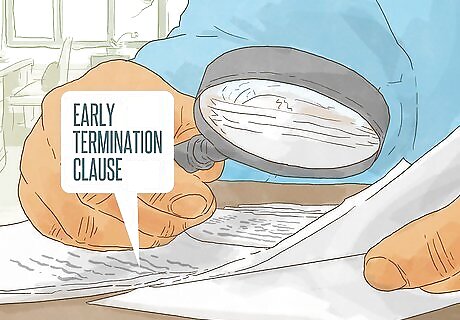
views
Checking If the Agreement is Enforceable

Check that NDA is sufficiently clear. A contract requires that both parties agree to the same thing. If the contract is too vague or unclear, then you might be able to argue that it is void. For example, Susan signs an NDA at her new job. The NDA says she can’t reveal anything about her company to anyone else. This NDA is probably too vague to be legal.

Identify whether each side received consideration. Consideration is the legal term meaning something of value. It can provide either a benefit or a detriment to either side. Both sides must give up something of value for a valid contract to exist. For example, both sides agreeing to keep information confidential qualifies as mutual consideration. One side giving you money or work also qualifies as consideration. Mary is neighbors with a famous politician, who is going through a brutal divorce. Mary overhears screaming fights and sees the police stop by more than once. She promises her neighbor that she won’t say anything. Mary’s promise is not a binding contract because she didn’t receive anything of value from her neighbor. Alternatively, if Mary's neighbor paid her to be quiet, then she received a benefit (the money) for the detriment of keeping the secret. In this case, both parties gave consideration.

Confirm the agreement is in writing. Due to the Statute of Frauds, an agreement generally must be in writing to be enforceable if it lasts for more than a year. If your NDA was only verbal, you can probably break it after a year.

Identify a misrepresentation. You can probably cancel an NDA if the other side made a misrepresentation of fact, and you relied on that misrepresentation. Misrepresentations can be affirmative untruths or a failure to disclose information. For example, Tyler is told that he’ll be given work if he signs the NDA. However, he is given no work in exchange, so he might be able to cancel the NDA for misrepresentation.

Assess whether the NDA is unconscionable. This is a vague standard, but unconscionability generally exists when the terms of the contract are entirely one-sided or oppressive. Often, the parties have unequal bargaining power and a lopsided NDA results. For example, Susan’s corporate employer gives her an NDA that prevents her from disclosing or using confidential information forever. This type of perpetual NDA is likely illegal. However, if the confidential information is a trade secret, then a court might uphold the duty not to disclose it.

Check whether the NDA is anti-competitive. Some courts will reject an NDA that prevents people from working. If an overly broad NDA prevents you from getting another job in your industry, then you can usually challenge the legality of the agreement. For example, Mike goes to work for Acme Networking Systems. They require that he sign an NDA not to disclose or use any of their confidential information for 10 years. After five years, Mike’s contract ends and he wants a new job in the IT industry. However, the company is trying to use the NDA to prevent him from finding work in the industry. In this situation, Mike might argue that the company is being anti-competitive by preventing him from getting another job. An NDA is not the same as a non-competition covenant. An NDA can ask you not to disclose information, but it cannot enforce this restriction by preventing you from taking another job. If you believe that your employer is trying to use your NDA to prevent you from getting another job in the industry, you can take it to court.

Look to see if the other side breached the agreement. If the other side has broken the NDA, then you might not need to comply with it. This is called a “breach.” However, the other side’s breach must be serious (“material”) to relieve you of responsibility for upholding your end of the contract. For example, Acme Networking Systems and Omega Fiber Optics enter into a mutual NDA. Each side agrees to disclose confidential information to each other and to safeguard it. However, Omega turns around and discloses Acme’s confidential information to a third party. In this situation, Omega has breached the agreement and Acme can get out of the NDA.

Consult with an attorney. These legal questions are difficult to analyze on your own. Every situation is slightly different, and only a qualified attorney can give you proper legal advice. Also every jurisdiction has its own laws regarding NDAs, and you need to know how a court in your jurisdiction will analyze the issues. Get a referral by contacting your nearest bar association. Call up the lawyer and schedule a consultation. Talk about what you should do if the NDA is illegal. For example, you might go ahead and break it, but you’ll be inviting a lawsuit in turn. Discuss your options with your lawyer so you can make an informed decision.
Terminating the Agreement

Identify why you want to terminate the NDA. The other side can agree to end a nondisclosure agreement early. For example, the confidential information might no longer have any value. This might be the best reason to end an NDA early. If you think the NDA is not legally enforceable, you can also ask the other side to let you out early for that reason. However, you can expect the other side to push back, since they probably don’t think they used an illegal contract. Check whether the NDA is about to expire. If it is, you can probably sit tight and not do anything.

Find an early termination clause. Some NDAs have clauses that explain how the NDA can be terminated by either side. Read your NDA to see if there is a clause. For example, it might read, “Either party may terminate this nondisclosure agreement by providing written notice to the other party. After termination, the Receiving Party’s obligations to the Disclosing Party are limited to the Confidential Information disclosed before termination was received.” In this example, you must maintain the confidentiality of previously-disclosed information until the NDA expires. Each early termination clause is a little different, so show it to your lawyer so you understand it fully.

Ask the other side to terminate the NDA. You should write a letter explaining why you think the NDA should be ended early. Format a business letter and keep your tone professional. Explain why you think the NDA is no longer necessary and ask to be let out of it. If you think the NDA is not enforceable, you should explain your reasoning. However, your lawyer should probably draft this section or at least review it. Realize that the other side doesn’t have to agree to let you out of a valid NDA, and they might disagree with you whether the NDA is unenforceable.

Draft a mutual rescission and release agreement. If the other side agrees to terminate the NDA, you should each sign a rescission agreement. Don’t simply take the other side’s verbal promise that the NDA has been suspended. Your lawyer can draft the necessary paperwork. A valid rescission agreement should identify the NDA by date and explicitly state that parties mutually agree to rescind the original agreement. Keep a copy of the signed agreement with your records.
Defending Against a Breach of Contract Lawsuit

Read the complaint. If you break the nondisclosure agreement, the other side might sue you for breach of contract. They will start a lawsuit by filing a “complaint” in court. The complaint will explain what information you disclosed without permission. You’ll receive a copy after the other side files the lawsuit. Read it closely. The person who files the lawsuit is the “plaintiff,” and they should identify clearly what confidential information you disclosed or used. They should state sufficient facts to support their allegation.

Assess whether the complaint is factually incorrect. Sometimes, the plaintiff doesn’t have their facts straight. They might accuse you of something you didn’t do. Consider the following: The information you revealed isn’t confidential. Read the NDA and check whether the information fairly falls within the definition of “confidential information.” You were allowed to use or disclose the information. Many NDAs allow you to disclose to third-party vendors in some situations. Read your NDA to see if the situation is covered. You didn’t use or disclose any information. Someone else might have disclosed the information.

Gather supporting evidence for your defenses. You can raise any defense in the first section of this article. Begin gathering as much information as possible to share with your lawyer. For example, if you think the NDA is anti-competitive, then all you need is a copy of the NDA. If the other side made misrepresentations, you should document them. Write down your own memories of any conversation you had with the other side and look for email communications. Another popular defense is to argue that the other side made the confidential information publicly available. Gather documentation. For example, a company president might have disclosed information when giving an interview to a trade publication.

Respond to the lawsuit. Typically, you will file either an “answer” or a “motion to dismiss” in response to the complaint. Check how much time you have to respond to the lawsuit. Read the summons, which should contain this information. In an answer, you admit or deny each allegation. If you don’t have sufficient information, you can also refuse to admit or deny. You should also raise any defenses that you have (e.g., why the NDA is illegal). If you don’t raise your defenses in the answer, you can’t raise them later. In a motion to dismiss, you ask the judge to throw out the case because the complaint is defective in some way. For example, you can argue the plaintiff filed the lawsuit in the wrong court.

Work with a lawyer on your defense. Each lawsuit is different. Your lawyer will investigate the facts and come up with your best defense. Talk with your lawyer about how the lawsuit will proceed. Generally, lawsuits follow this sequence: Discovery. This is the fact-finding phase. You can request documents from the other side, or give them questions to answer under oath. You might also participate in a deposition, where you answer question in person. Summary judgment motion. After discovery, either side might seek summary judgment. You ask the judge to decide in your favor because no set of facts can support the other side. Settlement. You can settle at any point in the lawsuit. In fact, settlement negotiations might be ongoing right up until a jury announces the verdict. Trial. Your lawyer will identify your witnesses and serve them with subpoenas. Ideally, your lawyer should also prep you for your testimony. You can have a trial before either a judge or jury.




















Comments
0 comment